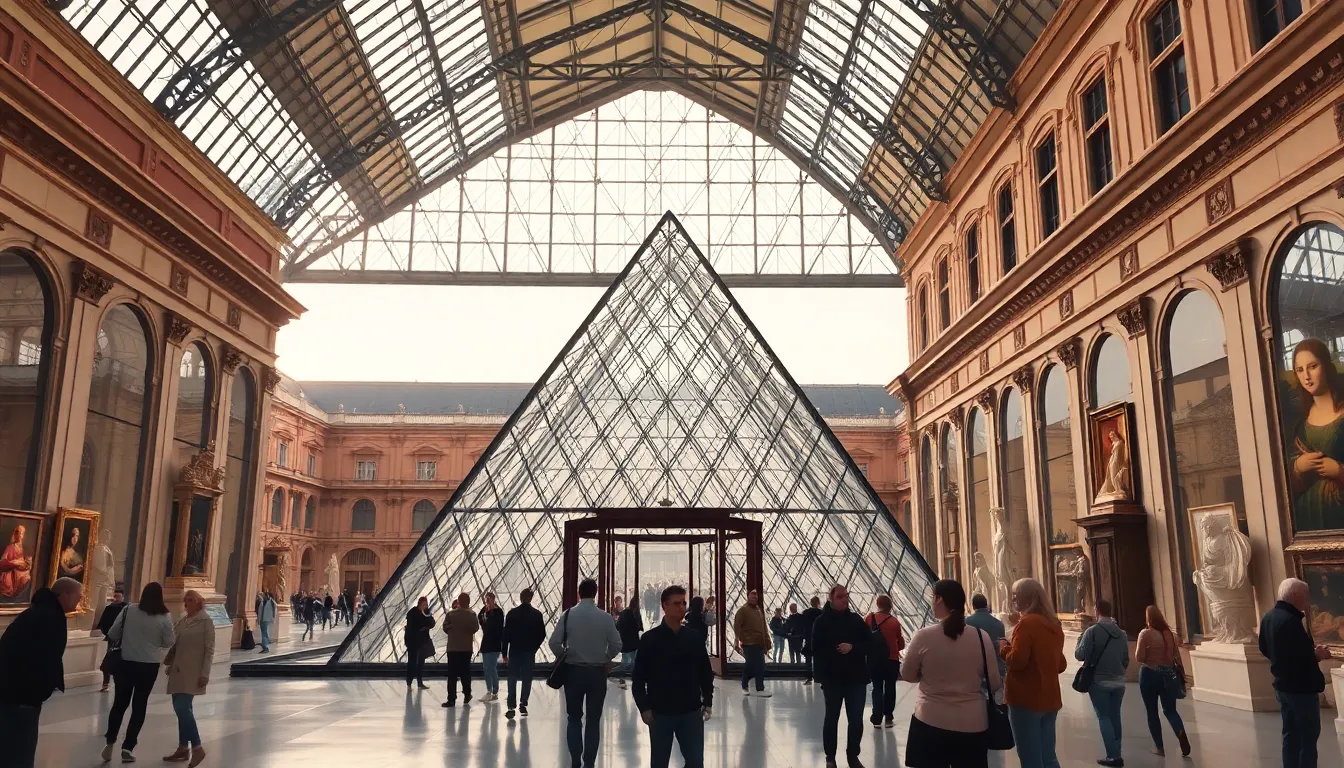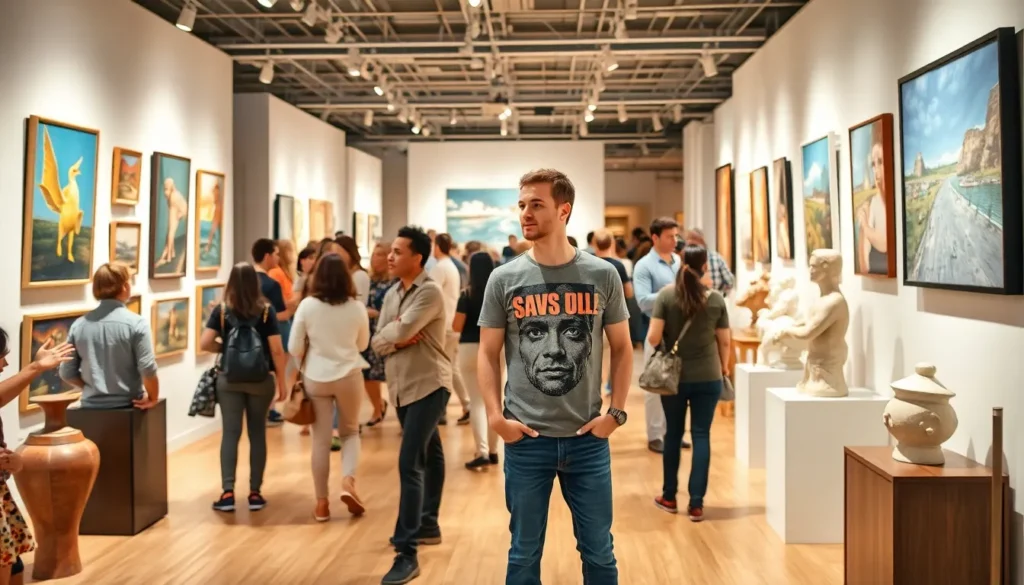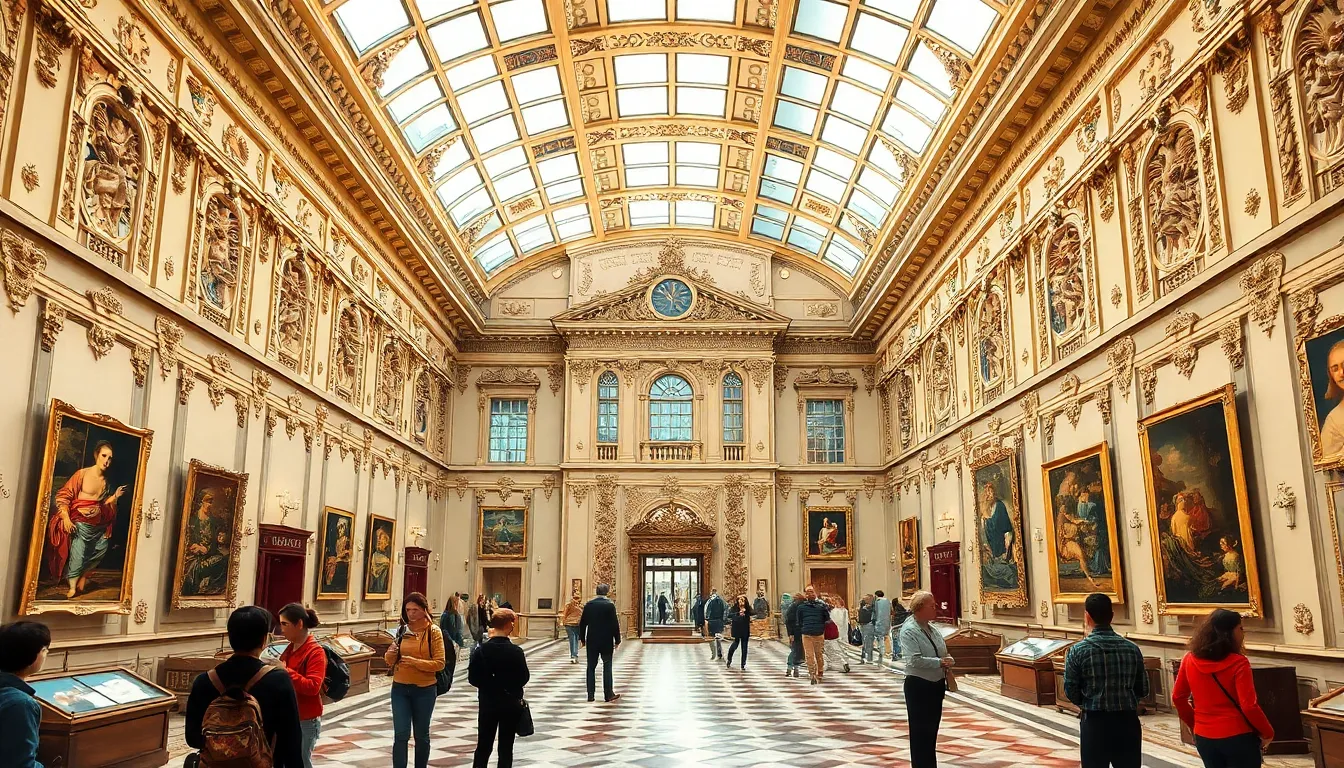Table of Contents
ToggleArt galleries are like treasure chests, brimming with masterpieces that can make anyone feel like a cultured connoisseur—whether they know the difference between Van Gogh and a paint-by-numbers kit or not. From the iconic Louvre to the bustling streets of New York, these artistic havens invite visitors to experience beauty, creativity, and maybe even a little confusion about what constitutes modern art.
As they wander through these hallowed halls, art lovers and casual strollers alike can revel in the stories behind each brushstroke. Who wouldn’t want to stand in front of a painting and pretend to ponder its meaning while secretly thinking about lunch? Famous art galleries offer a delightful blend of inspiration and entertainment, making them must-visit destinations for anyone looking to elevate their Instagram game or simply enjoy a day filled with creativity.
Overview of Famous Art Galleries
Famous art galleries attract millions of visitors each year, showcasing exceptional collections and breathtaking masterpieces. The Louvre in Paris stands out as one of the largest and most visited galleries worldwide, housing iconic works like the Mona Lisa and the Venus de Milo. Likewise, the Museum of Modern Art in New York features an extensive selection of 20th-century and contemporary art, including pieces by artists such as Van Gogh and Warhol.
Visitors often immerse themselves in various styles, from classical to modern art, while galleries like the British Museum in London display artifacts that narrate human history. Notable galleries, such as the Uffizi Gallery in Florence, focus on Renaissance artwork with pieces from masters like Botticelli and Michelangelo. In contrast, the Guggenheim in New York is renowned for its unique architectural design and modern art collection.
Art lovers frequently seek these spaces for inspiration and cultural enrichment. Galleries further offer educational programs and events that enhance the visitor experience, making art more accessible. Photogenic installations create opportunities for individuals to share their findings on social media, promoting engagement with art and culture.
Unique collections at famous galleries provide something for everyone, whether it’s centuries-old exhibitions or cutting-edge contemporary works. Enthusiasts travel from all over the globe to experience these treasures firsthand, highlighting the galleries’ significance in the artistic landscape. Each visit becomes a personal journey through art, inviting reflection and dialogue.
Iconic Art Galleries Around the World

Art galleries around the world showcase incredible works that captivate audiences. Each venue offers unique experiences and collections that resonate with visitors.
The Louvre Museum
The Louvre Museum in Paris stands as the largest art gallery globally, attracting millions. Notable masterpieces include the Mona Lisa and the Venus de Milo. This iconic museum spans roughly 782,910 square feet, housing over 38,000 pieces of art from various civilizations. Visitors encounter Egyptian antiquities alongside Renaissance artworks, creating a diverse artistic journey. The glass pyramid entrance enhances its architectural appeal, drawing attention to the gallery’s grandeur. Exhibiting some of the world’s most renowned pieces ensures its position as a premier cultural destination.
The National Gallery
The National Gallery in London houses more than 2,300 paintings, representing Western European art from the 13th to the 19th century. Iconic works by artists like Van Gogh, Botticelli, and Turner fill its halls. Located in Trafalgar Square, this gallery offers free admission, making art accessible to all. It organizes engaging exhibitions and educational programs that deepen understanding of art. A beautiful setting adds to the overall experience, allowing visitors to appreciate remarkable pieces amidst stunning architecture. Everyone can enjoy the gallery, whether they are lifelong art enthusiasts or casual visitors.
The Tate Modern
The Tate Modern in London showcases a remarkable collection of modern and contemporary art. Housed in a converted power station, its industrial architecture provides a unique backdrop for artistic expression. Visitors can explore works by artists such as Picasso, Warhol, and Hockney. Engaging exhibitions often focus on themes relevant to today’s society, inspiring reflection and dialogue. Admission to the gallery remains free, encouraging widespread access to modern art. Each visit offers a chance to discover exciting installations and thought-provoking pieces, solidifying Tate Modern’s reputation as a leader in contemporary art.
Emerging Art Galleries to Watch
New art galleries are gaining attention for their innovative approaches and unique collections. These emerging spaces reflect the evolving art scene, drawing in diverse audiences.
Local Favorites
In various cities, smaller galleries are becoming local favorites. For instance, Art Break in San Francisco focuses on up-and-coming artists, showcasing fresh talent and thought-provoking installations. Similarly, The Cactus Gallery in Los Angeles promotes local artists and fosters community engagement through various events. These galleries often provide a more intimate atmosphere and personalized experiences. Visitors frequently find themselves immersed in thoughtful curation and curated artist talks, enhancing their understanding of contemporary art.
International Hotspots
Across the globe, several emerging galleries are turning heads. The New Art Gallery in Walsall, UK, highlights contemporary works alongside modern collections, attracting art lovers with its diverse programming. The Pivô in São Paulo is another standout, featuring emerging Brazilian artists and experimental exhibitions that challenge conventional norms. Each of these hotspots showcases a unique vision, encouraging dialogue and exploration while supporting local and international art communities. Visitors consistently leave inspired and fulfilled, eager to see what’s next in these dynamic spaces.
The Role of Art Galleries in Culture
Art galleries serve as vital spaces for cultural exchange. They showcase not only masterpieces but also emerging trends and diverse artistic expressions. Educational initiatives abound, targeting various audiences and fostering appreciation for the arts. Visitors engage in workshops, lectures, and guided tours, enhancing their understanding of art and its context within society.
Many galleries actively promote community involvement. They partner with local artists, support initiatives that reflect regional cultures, and create a platform for underrepresented voices. Collaborative exhibits bridge gaps between traditional and contemporary art forms, creating dialogues that resonate with a wider audience.
Art galleries influence cultural identity. By displaying artworks from different eras and backgrounds, they encourage reflection on history and social issues. The debate surrounding modern art fosters vibrant discussions, which can challenge perceptions and broaden viewpoints. This critical engagement plays a pivotal role in shaping societal values and fostering creativity.
Famous locations like the Louvre, National Gallery, and Tate Modern exemplify the impact of galleries on a global scale. Each attracts millions of visitors, serving as hubs of inspiration and innovation. Emerging galleries also contribute significantly, offering intimate settings for contemporary art appreciation. Local spots like Art Break and The Cactus Gallery invite exploration and dialogue in unique ways.
Art galleries ultimately capture the essence of human experience. As cultural landmarks, they not only celebrate artistic achievement but also inspire future generations of creators and art lovers. In this way, they become integral to the ongoing narrative of culture and creativity worldwide.
Art galleries are more than just spaces to view art; they’re vital cultural hubs that foster creativity and inspire connection. Each visit offers a unique opportunity to engage with diverse artistic expressions and reflect on the human experience.
From the grandeur of the Louvre to the intimate charm of local galleries, these institutions play a crucial role in shaping cultural identity and encouraging dialogue. They not only showcase masterpieces but also promote emerging artists and innovative ideas.
As art continues to evolve, galleries remain essential in nurturing appreciation for the arts and supporting community engagement. Whether through educational programs or thought-provoking exhibitions, they invite everyone to explore the transformative power of art.



